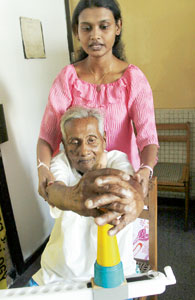Paralysis or numbness (lack of sensation) on one side of the body…….pick up the danger signal and get to a major hospital as soon as possible.
Think of the brain immediately, is the advice of Consultant Neurologist Dr. Padma Gunaratne not only for those who suspect that they may have suffered a stroke but also to loved ones who may notice something different.
One in six is the theme of the World Stroke Organization, Dr. Gunaratne, President of the College of Physicians and President of the National Stroke Association of Sri Lanka is quick to point out which means that one in every six persons develops a stroke.
The other signs and symptoms of a stroke are:
- A speech disturbance -- slurring when talking or a problem with language which may be manifested in the form of an inability to recognize what someone is saying or being unable to express oneself
- Vision impairment – either in one eye or loss of half of the visual field or having double vision. Usually when looking straight the visual field is 1800C
- Developing giddiness such as in a vertigo attack
- Difficulty in swallowing
- Difficulty in walking and acquiring a drunken gait
- Inability to control the passing of urine and faeces
Early identification is important because stroke is one of the “most devastating medical conditions” which can leave a person crippled for life, stresses Dr. Gunaratne pointing out that it is the second leading cause of death, next to cardio-vascular disease, among those who are over 50 years old.
Explaining that a majority of strokes are preventable, this Neurologist who has been campaigning for the setting up of dedicated ‘stroke units’ in major hospitals to provide maximum all-round care for stroke victims under a multi-disciplinary team states categorically that “strokes are curable”.
 |
| Rehabilitation at the Stroke Unit of the NHSL.
Pix by M.A. Pushpa Kumara |
The multi-disciplinary team which will get into action not only to cure the stroke victim but also rehabilitate him will comprise doctors, nurses, physiotherapists, occupational therapists, speech therapists, counsellors and social workers.
There is a lot that can be done if you bring the stroke victim to a major hospital immediately, MediScene understands.
Another warning that she delivers is – don’t ignore the symptoms if they pass within 24 hours because a Transient Ischaemic Attack (TIA) could very well be a precursor for a stroke.
A stroke is caused by diseased blood vessels rather than a disease of the brain, says Dr. Gunaratne, explaining that the brain, like every other part of the body needs a good blood supply to function. With age, however, the blood vessels become thicker with fat and cholesterol being deposited on them and ulceration occurring.
Thereafter, platelets get deposited, over which fibrin (a fibrous protein involved in the clotting of blood) and then red cells, which could result in the formation of a blood clot. Such a clot could block a blood vessel or pieces of that clot could dislodge themselves and cause a blockage elsewhere. Depending where such blockage has occurred in the vessels providing blood to the brain will the symptoms be manifested because different sections of this organ control speech, vision, sensation and motor abilities.
Eighty-five percent of strokes are ischaemic, caused by such blockages, she says, adding that the balance 15% are haemorrhagic strokes which occur when a blood vessel in the brain bursts, leading to bleeding into the brain. “As we grow older, our blood vessels lose their elasticity and the blood flows through with increased pressure. This pressure can lead to a vessel bursting.”
When managing a stroke victim, it is very important to identify the type of stroke as the treatment would be different. That is why a CT scan of the brain is vital, according to Dr. Gunaratne……..like an ECG for a heart attack, a CT scan is a must for stroke.
Brain cells will die in 5-10 minutes if they don’t get oxygen and glucose through blood and research has found that if it is an ischaemic stroke, the sooner a clot-buster is given to the patient, the better. “The ideal time period would be within 4.5 hours of having the stroke,” says Dr. Gunaratne, adding that clot-busters (rt-PA – recombinant tissue Plasminogen Activator) are acute or emergency management of strokes and cannot be given to all. “The selection criteria for clot-busting treatment are very stringent and the procedure is a complicated one which is only performed at the National Hospital.”
If clot-busting medication is administered to a haemorrhagic stroke victim, the bleeding will be aggravated, it is learnt.
Stroke units with multi-disciplinary teams are best equipped to handle strokes because immediate attention and follow-up rehabilitation are essential not only to prevent death but also disability, adds Dr. Gunaratne.
The Vital Six
Six important points to remember in the prevention and cure of strokes are:
- Avoid smoking
- Eat a healthy diet
- Do exercises
- Limit alcohol
- Be aware of your risk factors such as hypertension (high blood pressure), cholesterol and diabetes
- Be familiar with the symptoms of stroke and seek medical help
Dealing with the risk factors, Dr. Gunaratne says they include hypertension, smoking, diabetes, high-cholesterol, being overweight, lack of exercise, having a heart attack and a previous stroke. The minor risk factors are stress and for women the use of contraceptive pills.
Meet the
stroke team
Are you a stroke sufferer or a stroke care-giver?
If you have any questions, doubts or fears, you can meet the stroke team every first Thursday of the month at 9 a.m. at Ward 16 of the National Hospital, Colombo, and put your brain at ease.
|
